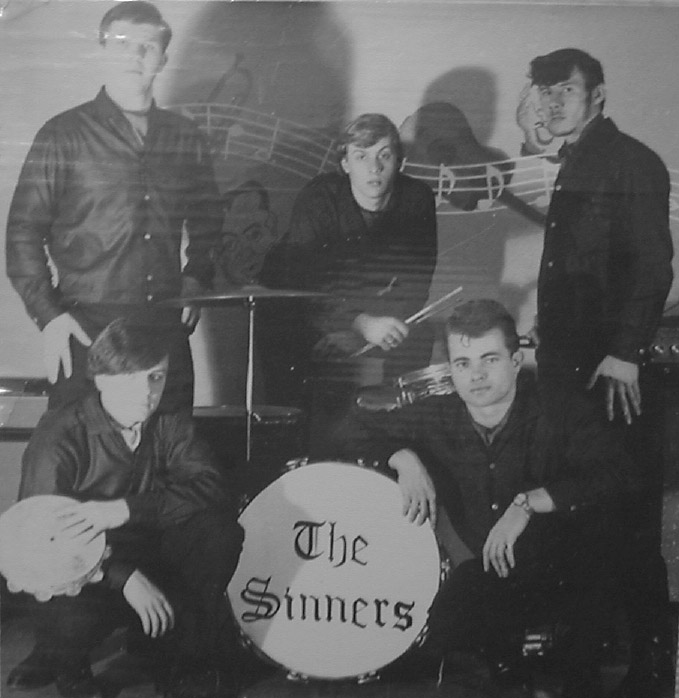
André Germain writes about his bands from Welland, Ontario, a short distance from Buffalo: The Sinners, Evan Hunt and the Capris and The Penny Illusion. Demos he recorded with the Sinners now seem to be lost, unfortunately. The Sinners evolved into the Mood, who cut a tough version of “Who Do You Love” for the Cove label after André had left the band.
The Sinners (1965-1966)
Ritchie Gauthier (aka Ritchie Stringer): vocals/rhythm guitar
Mike Weaver: drums/back-up vocals
Al Bartok: bass (later replaced by Glen Boscei)
Jack Schaefer: keyboards
André Germain: lead/rhythm guitar (later replaced by Dave Pine)
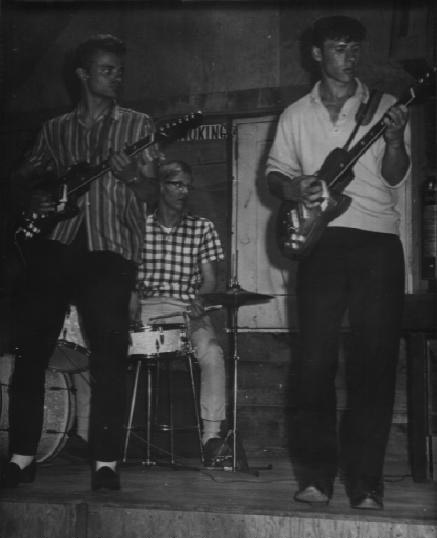
In 1964, one of my younger frat brothers was taking guitar lessons and he could chord along when we’d have a drinking party and get to singing songs such as “Lemon Tree”, “Tom Dooley” etc., as long as he had a music book with the chords and notes in front of him. Unfortunately he had a “tin ear” and could not even tune his guitar properly. Already 22 years old, I bought a cheap $20 Kent plywood acoustic guitar with “shotgun stringing” (really high and tough action) with the intention of learning a few basic chords so I could tell him the chord changes as we sang. Didn’t take long for me to get hooked on the guitar. Blisters on the fingers of my left hand, blood on the fretboard, until finally I developed thick calluses.
I borrowed my friend’s Kent solid-body electric guitar and his Paul amp when the frat rented a cottage for a couple of weeks in the summer of 1964. As luck would have it, we got “raided” by a rival frat from Pt. Colborne. These guys came in and smashed everything including the Kent and the Paul amp. One of my frat brothers got his nose broken when struck by a tire iron and another had a wicked bruise on his shoulder when another guy hit him with a small crowbar.
Fortunately, my friend’s parents’ home insurance replaced his guitar so I got to keep the broken Kent. I bought a piece of mahogany and carved another body for it, fitted the neck and the pickguard with its electronics to it and ended up with a decent playable guitar. I bought Ventures and Shadows and other guitar-based records and wore the grooves off of them trying to learn instrumentals such as “Apache”, “Walk, Don’t Run”, “Sleepwalk”, etc. This guitar played a lot easier than my cheap flat-top. Another one of my frat brothers who was into electronics added an input jack to our old Westinghouse (5-watt all tube) hi-fi so I could play the guitar through it. Nothing fancy but it worked.
I took to hanging out at the Melody Shop, a neighbourhood music store owned and operated by Tom Wright. Tom, in his late 40’s, let me take various guitars off the wall and play them through whatever amps he had in store. Sure was nice to have such access to pro equipment for free…
The Sinners
One fine day in the spring of 1965, a couple of weeks after having been laid off from Atlas Steels, as I was sitting in the living room of our family’s apartment playing my Kent, two young guys showed up at the door. They introduced themselves as Ritchie Gauthier and Mike Weaver, musicians whose band had just broke up and who were looking for a lead guitarist for a new band. Tom Wright had given them my name. They told me that they were planning on doing Top 40 material such as the Beatles and Rolling Stones, etc. They invited me to a practice at Mike Weaver’s mother’s house if I were interested. When I told them I didn’t even have an amp, they told me they’d have one for me to use. So, I agreed.
A couple of days later, I grabbed the Kent and off I went walking across town to Mike’s house. When I got there, they introduced me to Al Bartok, the bass player. Played a Fender P-bass through one of those Ampeg flip-top all-tube amps with a 15″ speaker. Ritchie Gauthier was the lead vocalist/rhythm guitarist and Mike Weaver was the drummer/back-up vocalist. These guys were all a few years younger then me, in their late teens.
Mike and Ritchie played some 45’s on a portable record-player and explained what parts they expected me to play on any given song. Graced with a decent “musical ear”, I had no trouble picking up on the simple chord patterns and the lead fills of most of the pop songs of that era. Most were 3 or 4 chord structures in C, D, E, G or A. And so I was drafted into the band.
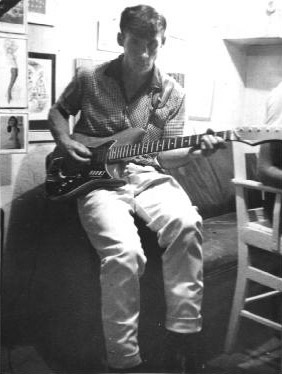
Of course, one of the toughest things a band back then was faced with was coming up with a good catchy name. We bandied a few monikers around and finally settled on one I suggested, “The Sinners”. We then reworked an old gospel tune, “Sinner Man”, giving it a rock beat, and made it our theme song. “Sinner man, where you gonna run to, sinner man, where you gonna run to, sinner man, where you gonna run to, all on that day?!!”
It took two or three weeks of practice to work out enough songs to be able to play a gig. Our song list included such hits as the Rolling Stones’ “Time Is On My Side”, “Walking The Dog” and “Get Off Of My Cloud”, Fontella Bass’ “Rescue Me” which Ritchie sang in a high falsetto, the Beatles’ “I Saw Her Standing There”, Sam the Sham’s “Wooly Bully” and Sonny and Cher’s “Everyone’s Gone To The Moon”. Ritchie and Mike let me take the 45s home so I could work on the guitar riffs and everything was coming together really well.
That’s when I decided I needed to get a “real” guitar and amp. I went to the Melody Shop and asked Tom what kind of a deal he could do me. He’d just gotten a sunburst Gibson ES-330 in trade and offered it to me for $250 with HS case but at the time, that wasn’t my idea of a R&R guitar. Hate to think what that guitar would be worth today! Tom then pulled out a glossy folder advertising a line of guitars out of England. Well, the UK was big news back then with the British Invasion just taking off in N. America! The guitars were the Burns of London line. Already a big fan of the Shadows, how could I resist? I had Tom order me a transparent orange/red NU Sonic. It listed for $325 but Tom sold it to me for $250 with faux alligator case thrown in. I also bought a new Harmony H-306 all-tube amp off of him. 12AX7 pre-amp tubes and push-pull 6V6’s for the power section, footswitchable “Normal” and “Tremolo” channels, single 12″ Jensen speaker, putting out a hefty 15 WRMS. So, in the immortal words of the Bard’s Julius Caesar, the die was cast.
We played a few high school and teen dances and were going over pretty good. There were a lot of high school frats and sororities around at the time and they often held dances to raise funds. A lot of these dances took place at the Knights of Columbus Hall on Lincoln St. W. in Welland. We played there quite a few times. The Rose Festival Committee of Welland hired us to play a big dance at the Welland Arena where two stages were set up, one at each end. The Spartans, another local band, occupied one stage and we the other. We alternated sets.
One of the highlights for me was when Rick Hales who was president of the Welland High & Vocational School Dance Committee hired us to play a Valentine’s Dance in February 1966 at WH&VS, my old alma mater. At another high school dance (Eastdale Secondary School) Al broke a string on his bass during the first set and had no replacement. He made do with the remaining 3 strings but as soon as the set was over (about 9:40 pm) we phoned Bill Nitranski, owner of Central Music. Bill had been building up his music store business over the previous few years and was one of those really nice guys who trusted everybody. He’d rent out equipment such as P.A. systems just on your promise to pay when you brought the stuff back. When we described our plight to Bill, he jumped in his car, drove back to his store which had closed at 9 pm., got a replacement string and delivered it to the high school auditorium where we were performing, all this within 15 minutes! By the time we were to go back onstage, Al’s bass had the new string on it.
After a few weeks Ritchie and Mike suggested we should add keyboards to the band. Right off, I suggested my good friend Jack Schaefer. Jack had taken accordion lessons for 10 years, classically trained, and won 1st. place in one of those kids’ talent shows that were popular on TV back in the late 50’s. The guys agreed to give him an audition. I called Jack and explained to him he’d have to buy an electric organ and an amp if he were to make it into the band. He said that wasn’t a problem. He immediately went out and bought himself a Hohner organ and a huge Gibson Atlas amp with 15″ driver. Jack had an excellent ear and picked up on our songs in no time. Fit right in. Only trouble was that he liked to play everything flat out full volume. Wasn’t long before I had to upgrade my amp just to be heard. Tom Wright at the Melody Shop told me his friend Grant Carson of The Country Diamonds, a local C&W band, was trading in his ’63 Fender Bandmaster for a Fender Dual Showman so I got the Bandmaster at a good price.
On the Road
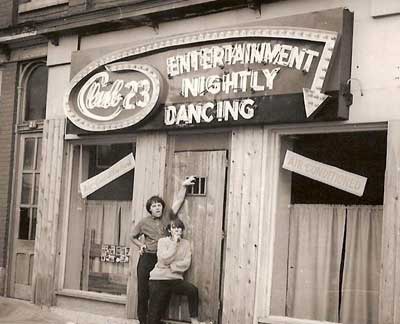
Neil Peart, the famous drummer for Rush, describes in his book “Road Music” how he spent a lot of time in his youth at the Lincoln Curling Center grooving to live bands. There’s a good chance we were one of those bands because we played there a few times in 1965. Around this time, we were approached by Mike Addario, the bass player for The Marquis, another local band. Turns out Mike was trying his hand at being a booking agent/manager as well as a recording engineer. He soon got us a full-week gig at a teen club in Cornwall, Ontario. This caused a big shuffle in the band. Al’s mother wouldn’t let him go with us to Cornwall for that gig. We got Glen Boscei to take his place on bass. Jack Schaefer had just gotten a job as a teller at the CIBC in Welland and wasn’t about to jeopardise a burgeoning banking carreer so he opted out of the band then too.
So off we went on a hot August Sunday morning, Ritchie, Mike, Glen and I, with all our gear in a rented U-Haul trailer hitched to the back of Ritchie’s father’s car, to the bus station in St. Catharines. After waiting 4 hours for our bus, we ended up missing it because, having been given wrong info, we were on the wrong loading platform. The Greyhound company ended up having to re-route an Express to Montreal through Cornwall to accommodate us. That was a long day. We’d gotten to the bus station at 8 a.m and didn’t get to Cornwall until 1 am that night. The owner of the club where we were to play had been notified of the bus change and had patiently awaited our arrival. He helped us load our gear aboard a taxi and sent us off to a motel room he’d booked for us. I still have a very vivid memory of stepping off the bus and gagging as the rotten cabbage smell of the town’s air hit my nose. Cornwall’s main industry at the time was a pulp and paper mill and anybody who has ever been in the vicinity of one of those will know what I’m talking about here…
After a bad night’s sleep and a greasy restaurant brunch, we loaded our gear aboard a taxi and went to Club 23 to set up. We were to play from Monday through Saturday, 8 p.m. until midnight and also a matinee from 3 p.m. until 5 p.m. on the Saturday where we shared the stage with Wee Five, the band that would be playing there the following week. This was mid-August and Cornwall was in the midst of a heat wave. The club had no A/C so it got hot in there when the local teens filled the place. Ritchie kept tossing back cold drinks in spite of my warnings and by Thursday evening, lost his voice! All that was coming out of him was a croak. Good thing Mike and Glen were able to take up the slack or we’d have been sunk. Between sets, Ritchie helped Mike write out the words to the songs he and Glen would be doing and that got us through the rest of the week. Meanwhile I developed some kind of intestinal infection and suffered bad stomach cramps most of the week and lost about 10 pounds by the time Saturday night came along.
So, that was my introduction to “the road”, and it was enough to convince me this was not the life I wanted, as much as I liked playing music. Our agent, Mike Addario, was supposed to call us and tell us where we’d be going from there, what gig would be next, but by the week’s end we still hadn’t heard from him. Finally, on the Sunday, we phoned him and he told us we could stay put there at the motel (at our cost!) and he’d be sure to find us another gig. Well, I told the guys I was heading back to Welland while I still had change in my pocket. They had a confab and decided that was the smart thing to do so we packed our gear and took the next Greyhound home.
Recording and leaving the band
Mike Addario had set up a rudimentary recording studio in his parents house’s basement and called his company “Canland Recording”. There, we recorded two songs, our original version of “Sinner Man” and “Ten Dollar Woman”, a tune penned by Glen our bass player. Mike did a decent job of the recording with what little he had to work with and the finished result sounded pretty good. Unfortunately, when he tried to register the songs with ASCAP, the B side, “Ten Dollar Woman” was turned down because its content was considered too risqué. The song was about a prostitute who was too expensive for a cheap would-be client (a five-dollar man). I asked Mike Addario if perchance he still had the master tapes of the Sinners songs we recorded but he said they got lost a long time ago, more’s the pity.
It was around this time that I was really getting into the acoustic guitar and folk music, spending all my time trying to learn Tom Rush and Gord Lightfoot tunes. This pissed off my fellow bandmates who were getting ready to go back to Mike’s studio to record another song for the B-side of our record. One day a friend of mine came along and told me he’d just gone by Glen’s house, heard the band practicing and wondered why I wasn’t there. I walked over to Glen’s and sure enough, I could hear the band but nobody’d told me about a practice… I knocked at the door but nobody answered (probably couldn’t hear me over the instruments) so finally I just walked in. Mike, Ritchie and Glen looked mighty sheepish when I appeared. They had a guy playing lead guitar so it was obvious I was being replaced. Mike and Ritchie mumbled excuses about me bing a “folkie” and not fitting in with the band anymore. So that was that! The new lead guitarist introduced himself as Dave Pine. I’d heard of him and knew he was good on his instrument as well as being a fine vocalist, so I wished the guys well and walked out of there.
Some months later I heard that the Sinners, now called “The Mood”, had gone back into Mike’s Canland Studio and recorded the B-side with Dave Pine singing a rendition of “Who Do You Love” [Released b/w “Train’s Late” on Cove Records, produced by Pete Borbely]. And then, the next thing I heard was that Dave had left the group and headed to Toronto to seek his fortune. Over the years, he headed a couple of jazz/R&B groups up there and managed to make a decent living with his music. Then late one night after a gig, he wrapped his car around a tree and suffered some major injuries. He was in a coma for a while, touch and go, and never fully recovered from the accident. He spent the remainder of his life in a wheelchair and died a broken man a few years back. Tragic!
After Dave left the Sinners, Glen soon was out of the picture as well. Ritchie switched over to bass guitar and Chris Smith, a young guitarist out of Port Colborne, took over as lead guitar. The trio changed their name to Factree and later, Tree. They played locally and released a couple of singles. And then another tragedy. Around 1971, the newly-wed Mike Weaver collapsed on stage in the middle of a gig. His doctor recommended at least a month of rest but Mike was back at his drumming within a week. Shortly thereafter he collapsed again but this time, it was fatal. He left behind a young wife and a baby. Sad…
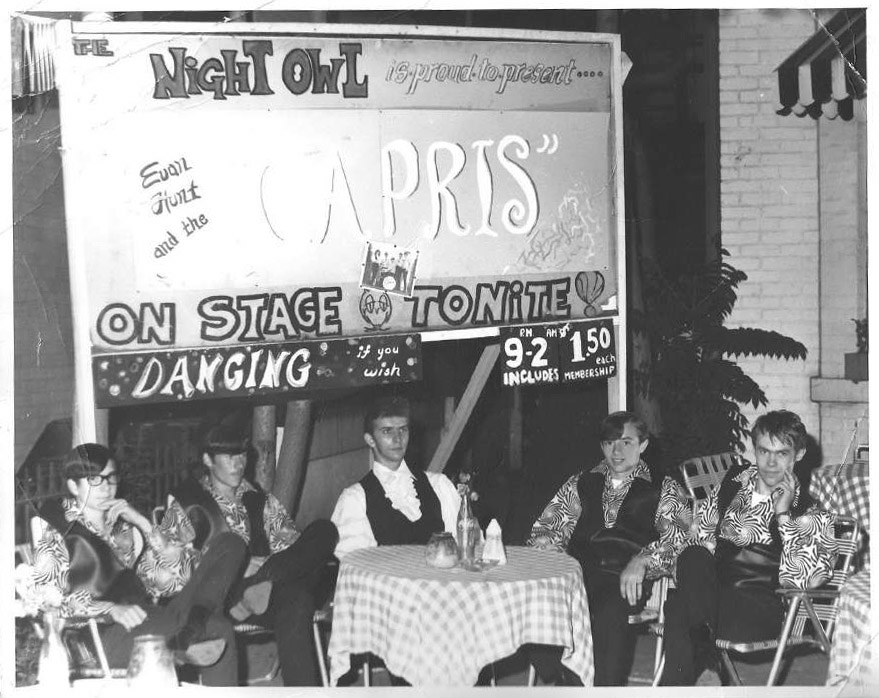
Photo courtesy Ron Bovine
Evan Hunt and the Capris (1967-1968)
Evan Hunt: vocals
John Lane: drums
Bob Vida: bass (soon replaced by Ron Bovine: bass/back-up vocals)
Bob Lightheart: keyboards/back-up vocals
André Germain: lead/rhythm guitar/back-up vocals
Meanwhile, about a year after losing my job with The Sinners, another knock at my door. The man introduced himself as Mr. John Lane, manager and agent of a local band, The Capris. He explained the band had just hired Evan Hunt as singer/frontman. Evan had been vocalist for The Liverpool Set, a Canadian “British Invasion” band which had had fair success in the States doing Beatles and Byrds tunes as well as some original compositions. Mr. Lane said he was ready to do anything it might take to make the Capris a successful band. Tom Wright from the Melody Shop had again recommended me. I explained that I’d sold all my gear. Mr. Lane said that was ok, that I could use his son’s gear. Turns out he was firing his one son who had been playing lead/rhythm guitar for the group because he wasn’t cutting it. His other son John Jr. was the drummer for the band. I asked him to give me a couple of days to think it over.
The next day, Evan Hunt and John Lane Jr. both showed up at my door and begged me to come and try out for the band. So, that’s what I did. I used Mr. Lane’s son’s Gibson Firebird and his Ampeg amp for the audition. Right off, after a couple of songs, one of which was Buffalo Springfield’s “For What It’s Worth”, the guys in the band wanted me to join. I said OK and that was that.
As luck would have it, the very next day, as I was contemplating going to Tom’s music store to purchase a guitar, I got a call from the guy who’d bought my Burns after I left the Sinners. He explained that his band had just broken up and he needed money so wondered if I was interested in buying the Burns back. Of course I jumped at the chance, especially since he was giving it back to me at half the price for which I’d sold it to him!
Up until the time Evan and I joined the band, The Capris had been a pretty “square” band, not hip at all, the guys wearing these preppie dress pants and off-yellow cardigans over white shirt and tie. Mr. Lane explained how he wanted “his boys” to be neat and professional looking. Well, Evan and I told him that just didn’t cut it in 1967! Ok for a polka band maybe, but definitely not for a Rock band!. The “Hippie Revolution” was in full swing and all the wild psychedelic clothing was de rigueur for any would-be hip band. Even The Beatles had forsaken their mod suits, grown their hair long and were wearing sandals and beads. Finally, Mr. Lane caved to our arguments and off we went shopping for wild outfits. Mrs. Lane asked us to pick out material, took our measurements and fashioned us each a pair of groovy bell bottoms. Black slip-over leatherette vests completed the outfits. Evan was the only one in the band with shoulder-length hair, however…
While all this was going on, we were rehearsing almost daily, striving to learn enough top 40 material to play a gig. Songs by The Beatles, Paul Revere and The Raiders, Tommy James and the Shondells, Jefferson Airplane, etc. Soon, Bob Vida, the bass player, decided this was not his trip and wanted out so we got Ron Bovine to take over on bass. Ron worked right in and the band, now called “Evan Hunt and the Capris”, came together and clicked.
Mr. Lane was holding up his part of the bargain and got us some gigs, highschool dances, teen dance clubs etc. in the Niagara penninsula. Evan was the consummate showman on stage and knew how to work the audience and we soon built up a following. When we played the Niagara Falls Youth Center, there were at least 800 teens in the audience and some of the girls, screaming in frenzy, were actually trying to get up on stage to get at Evan. So this was the bigtime (even if the money was still smalltime…)!
And then one day Mr. Lane announced he’d booked us into The Night Owl in Toronto! This club was THE happening place. It was the venue where the Loving Spoonful played when they came to Toronto. In fact, John Sebastian of the Spoonful had composed a harmonica tune, the B side of one of their 45’s, entitled “Night Owl Blues”, named after that club. This place was famous. We were to play 3 nights there, Thursday through Saturday. We rented strobe lights and extra electric gear, a couple of amps etc., to round out our stage gear so that we’d appear pro enough to fit into that venue. We couldn’t afford to rent a place to stay in Toronto for the 3 days so we travelled to Toronto and back, 90 miles each way, in Evan’s ’65 fastback Mustang and John Lane Sr.’s Crown Vic, before and after each gig, getting home at 3:30 a.m. after playing until 1 a.m. We had good crowds all 3 nights at the Night Owl and the audience responded well to our performances. It was starting to look like our careers as musicians, as a band, were about to take off…
Then reality set in.. After we finished up on Saturday night, packed all our gear in the rental U-Haul trailer and headed back to Welland, when came time to get paid, John Lane told us we each owed him $10! Say what???!!! We’d just played a prestigious club for 3 nights, played our hearts out, spent hours travelling back and forth between Welland and Toronto, to find out we’d done this for nothing? No, worse than nothing! All that work and effort and we were each in the hole $10! At the time, music, the band, was my only livelihood. Typically I expected to earn at least $100 to $150 for a 3-night gig. Evan, Bob and Ron were just as taken aback as I was at the news we’d just worked for nothing. John Lane explained that he’d booked us in the Night Owl for next to nothing in order to “open doors to greater things”. Well, possibly it was a good business move but we felt we should have been privy to this decision as it directly affected us. Had we been consulted with the facts, we might have agreed to the terms although I doubt that would have happened because, especially in Evan’s and my case, we were relying on the money from our gigs to live on. We had no other source of income. John Lane owned a motel and was financially secure. His son John Jr. lived at home with his parents and didn’t have to worry about starving. So, for that matter, did Bob and Ron. I didn’t have the $10 to give John and neither did Evan. Mr. Lane told us he would take it out of the money from the next gig but Evan and I conferred and then told him to go to hell! We told John Jr., Ron and Bob that we were leaving and would form our own band. Bob and Ron decided to stick with us and that’s when we found another drummer, Jeff Burgess, to replace John.
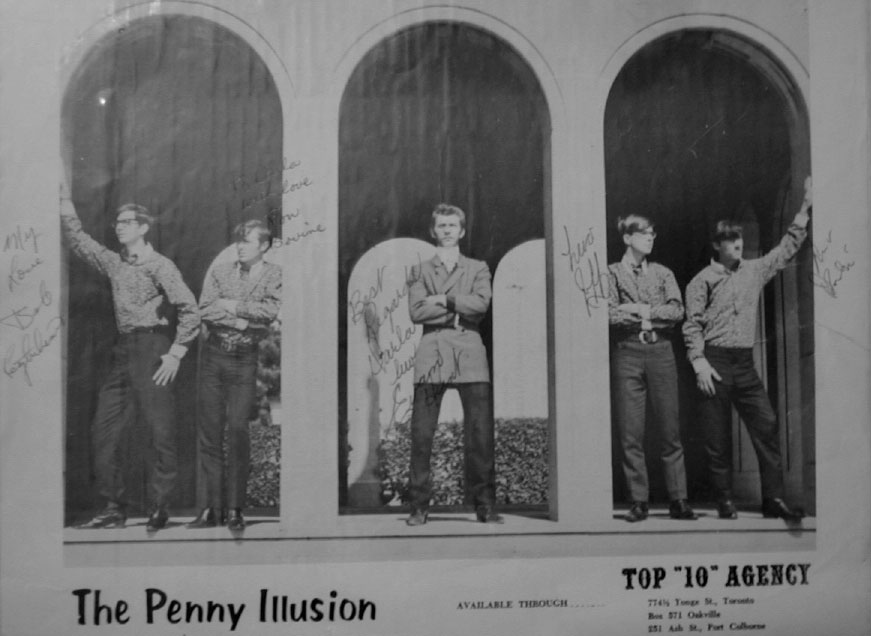
The Penny Illusion (1968)
Evan Hunt: vocals
Jeff Burgess: drums/back-up vocals
Ron Bovine: bass/back-up vocals
Bob Lightheart: keyboards/back-up vocals
André Germain: lead/rhythm guitar/back-up vocals
We changed our name to “Penny Illusion” (I came up with that name out of disillusionment after being cheated out of our fair pay for that Night Owl gig). We managed to find a few decent paying gigs over the next couple of months but it was tough trying to keep things together, being our own agents/managers/bookers. We somehow got hooked up with a smooth talker, a rep from Top 10 Agencies in Toronto who lived in Pt. Colborne. He promised us the world and delivered nothing. The Penny Illusion never recoded anything, we weren’t together long enough to get that together.
Bob Lightheart and Ron Bovine had both graduated from highschool and were faced with tough career choices. Their parents were pressuring them to get into further education, college or university. The music business, after all, was very chancy at best. Come the fall of 1968, both of them wisely chose to go on to university and that was the end of that band. I’d managed to get hired as a casual worker for Canada Post in late 1967 and in October 1969 became a full-time employee and gave up the music business.
Evan went on to sing for a couple of other local bands while getting work driving a delivery van for a local bakery to support his wife and newborn son, Evan Jr. A while later, another son came along but by then I’d pretty well lost track of what was going on with the lives of the ex band members.
Al Bartok, the Sinners’ original bass player, to the best of my knowledge never played in another band after leaving the Sinners. He came down with meningitis in 1991 and was being treated at St. Joseph’s Hospital in Hamilton at the same time that Jack Schaefer, the ex-keyboardist for the Sinners who had pursued a successful career in banking, working his way up to Manager of a business branch of the CIBC in Hamilton, was being operated on for a brain tumour. Al died at the age of 44 on the day Jack was released from the hospital. Then later the same year, after having undergone painful radiation and chemothereapy, Jack also gave up the ghost at the age of 47, leaving behind a wife and two teen-aged children.
Glen Boscei, the bass player, had always had some “issues”. He was later diagnosed as suffering from schizophrenia. He lived his life on meds which helped control the disease but at times, when he “went off the meds”, he was not a pleasant person to be around. Finally, a couple of years ago, he allegedly knifed a man in Welland, was thrown in jail and died mysteriously “of unknown causes” there in his cell a couple of days later.
Ritchie Gauthier played in a few bands in the 1970’s and later started his own roofing company, I believe. He retired a few years ago and moved to North Bay.
Evan Hunt died in British Columbia at the age of 59 in 2005. Ron Bovine completed university and became a pharmacist. I have no idea what happened to Jeff Burgess and Bob Lightheart although I suspect that Bob may have taken over his family’s dry-cleaning business.
In the early 70’s some friends and I got together and formed a folk group, “Tobacco Rudy.” We played on weekends at local coffeehouses for a couple of years until the other guys in the band decided to change the format to rock and go off on the road.
I had gotten married in 1971, planned on starting a family and was still working for Canada Post so no way I was going off chasing rainbows. So, I was out of a gig again. I took a hiatus from performing for a few years. I quit Canada Post in 1979 because of an old back injury which came back to plague me. After an ill-fated canoe manufacturing venture, I put the word out and managed to get work playing lead and bass in various local country, country-rock and classic rock groups from 1982 until 1995. Since then, I’ve gotten back into folk music and perform at local coffeehouses periodically. I also get together and jam with a couple of old friends once in a while.
Early September, 2009, the members of Tobacco Rudy had a re-union here at my house along the lake. The only one not present was our drummer, Jim Acursi.
Of the original Sinners, Ritchie Gauthier and I are the sole survivors.
André Germain
